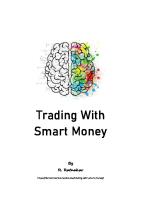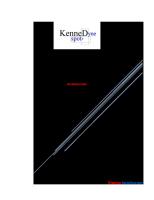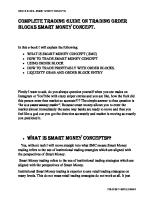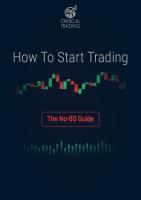How To Study Candlestick - Trading With Smart Money [PDF]
12/18/2020 How to Study Candlestick - Trading with Smart Money Price Action How to Study Candlestick Candlestick
49 1 211KB
Papiere empfehlen
![How To Study Candlestick - Trading With Smart Money [PDF]](https://vdoc.tips/img/200x200/how-to-study-candlestick-trading-with-smart-money.jpg)
- Author / Uploaded
- VIGNESH RK
Datei wird geladen, bitte warten...
Zitiervorschau
12/18/2020
How to Study Candlestick - Trading with Smart Money
Price Action
How to Study Candlestick Candlestick Analysis Price Action Analysis
How to Study Candlestick Back to: Trading with Smart Money
Advanced Price Action Analysis
How to Study Candlestick in Trading
Thrust Pullback and Measuring Move Analysis
How to Trade with Smart Money
How to Trade with Supply and Demand Zone
How to Day Trade with Trend Multiple Time Frame Analysis
In this article, I am going to discuss How to Study Candlestick in Trading. As part of this article, we are going to discuss the following three important pointers in detail which are related to Candlestick in Trading. 1. What is a candlestick? 2. How to Study Candlestick? 3. The 6 principles for analyzing candlestick
What is a candlestick?
Head and Shoulder Pattern How to Trade with Support and Resistance
Advanced Candlestick
The candlesticks are the reflections of what buyers and sellers are doing. What extent they move the price and the strength behind the move. CANDLES TELL YOU who is in control but do not tell you about the strength of buyer or sellers behind the move, candle with volume shows that
Analysis
Trendline Trading Strategy WRB Trading Strategy Day Trading Strategies
VWAP Trading Strategy How to Day Trade with the 5 simple Gap trading strategy
Intraday Open High Low Strategy
PIN BAR Trading Strategy Trading with Sideways Price Action Area
Pullback Trading Strategy Intraday Breakout Trading Strategy Risk Management
3 Techniques for Risk Management in Trading Stock Selection & Live Scanner
How to make own Day Trading Scanner
How to Select Stocks for Intraday Trading Intraday Trading Course 2020
Intraday Trading Course Multiple Timeframe Analysis for Intraday Trading
VWAP Trading Opening Range Trading
The Open: Open price tells us where the balance between buyers and sellers at the opening of that period, the opening value is the first trade of the day. After the traders have time to review the markets overnight, the open represents the desired position of investors to begin the day. The change from the previous close to the open is a reflection of new sentiments. Also, institutions looking to accumulate (or distribute) a position often place orders at the open because the open trade is often the largest, most liquid trade of the day. In this way, the open might be one of the best times to accumulate/ distribute a large volume of stock while minimizing the impact on the stock’s price.
The High: The high is the highest point the stock traded during the session. The high is the furthest point the bulls were able to push the stock higher before sellers regained control to push the stock back down. The high represents a stronghold for sellers and a resistance area to buyers. There is one exception when the stock closes on the high, it did not encounter any real resistance from the sellers. The buyers just ran out of time.
The Low: The low is the lowest point the stock traded during the session. The low is the furthest point the bears were able to force down the stock before buyers regained control to push the stock up. The low represents an area where enough demand existed to prevent the price from moving lower. The exception is when the security closes on the low. When the stock closes on the low, it did not encounter buying support. Rather, the bulls were saved by the closing bell of the session.
Strategy
Opening Range Breakout Volume Price Action Analysis
Stock Volume Analysis in Trading
Volume Price Action Analysis https://dotnettutorials.net/lesson/how-to-study-candlestick/
The Close: Close price tells us where the balance point was at the end of the period. The close is the last price agreed between buyers and sellers ending the trading session. The close is the market’s final evaluation. A lot can happen between one close to the next close. The close represents investors’ sentiments and convictions of investors at the end of the day. It is the position investors desire to hold after-hours when investors are unable to trade with liquidity until the next session opens. The closing price is the first (and oftentimes, the only) price the majority of investors desire to know. 1/6
12/18/2020
How to Study Candlestick - Trading with Smart Money
Volume Spread Analysis in
The Change:
Trading
Candlestick Pattern Analysis
The change is the difference between close to close. The difference in the closing value one day versus the closing
Finding Entry Opportunity
value the next day. When this difference is positive, it tells us that demand is outweighing supply. When this difference
using Volume Spread Analysis
Spring and Upthrust Trading Strategy
VSA Trading Strategy Option Chain Analysis
Option Chain Analysis Indicator
RSI Trading Strategy BTST
BTST Trading Strategy
is negative, it tells us that supply is increasing beyond demand. The change is perhaps the most sought after piece of financial data on the planet.
The Range: The range is the spread of values within which the stock traded throughout the day. The range spans between the bar’s highest point and the same bar’s lowest point. It is measured from the top of the bar, where resistance set into low, where support came in. The size of the range gives us important information about how easily demand can move the s took up or supply force the price down. The wider the range, typically, the easier it is for the forces of supply and demand to move the stock price.
Bullish CANDLESTICK This is nothing but when CURRENT CANDLE close is ABOVE the previous candle close.
TECHNICAL ANALYSIS MASTERCLASS
Technical Analysis Market Structure Understanding Market Structure through Swing
Supply and Demand Trading
Bearish CANDLESTICK When CURRENT close is BELOW the previous candle close
With the proper understanding of CANDLESTICK, you can predict what about to happen in the near future #Pro tips, we (retailers) can’t move the market so every candle shows what smart money trying to shows. So their move trap or genuine is only validated by volume #Pro tips, CANDLESTICK shows half information, another half information shows by volume Example
https://dotnettutorials.net/lesson/how-to-study-candlestick/
2/6
12/18/2020
How to Study Candlestick - Trading with Smart Money
WHAT IS TELLING US? SENIMATE= BULLISH, 2 consecutive higher close candle. Let’s add volume to this candle
2nd candle range smaller than 1st candle 2nd candle volume greater than 1st candle Think why volume is greater than 1st candle? Let me explain to you NARROW SPREAD CANDLE WITH HIGH VOLUME. Two possible explanations
If the volume had represented buying, how can the spread be narrow? Either the professional money is selling into the buying, possible reversal on near future There is a trading range to the left and the professional money is prepared to absorb the selling from traders locked into this old trading range. I mean break out may happen Let’s understand with chart
If the next bar is down closing near its lows this confirms the professional selling
Low volume down candle close middle or top, it shows that smart money testing supply and no more supply available 2nd candle was buyer’s volume if the next candle closes above the current candle
6 PRINCIPLE FOR CANDLESTICK ANALYSIS IN TRADING https://dotnettutorials.net/lesson/how-to-study-candlestick/
3/6
12/18/2020
How to Study Candlestick - Trading with Smart Money
Principle Number One: The length of any wick, either to the top or bottom of the candle is ALWAYS the first point of focus because it instantly shows, strength, weakness, and indecision, and most important where SMART-MONEY enter Principle Number Two: If no wick is created, then this signals strong market sentiment in the direction of the closing price. SMART-MONEY active there Principle Number Three: A wide-body represents strong market sentiment and a narrow body present week market sentiment Narrow body with the heavy volume either Smart Money observing for continuous of move or Smart Money enter on the opposite direction Principle Number Four: A candle of the same type will have a completely different meaning depending on where it appears in a price trend. Start of trend or middle of the trend or end of the trend or at support or resistance or in the consolidation phase. Candlestick should analyze the context of the move. You should never try and read the market looking at one day’s action in isolation. Always read the market phase-by-phase and then read the latest day’s action into the phase Principle Number Five: Volume validates price. First, see what CANDLESTICK is telling then validated by volume, is It validating or not with the CANDLESTICK price action Principle Number SIX: When a particular timeframe DON’T make sense then move to the next higher time frame for the big picture or lower timeframe for the microstructure of move
What next? In the next article, I am going to discuss the Price Action Analysis in detail. Here, in this article, I try to give a brief introduction to candlestick and I hope you enjoy this article. Here, in this article, I try to explain How to Study Candlestick in Trading. I hope you enjoy this How to Study Candlestick in Trading article. Please join my Telegram Channel to learn more and clear your doubts. https://t.me/tradingwithsmartmoney.
← Back to Course
Trading with Smart Money
Next Lesson →
Candlestick Analysis
12 thoughts on “How to Study Candlestick” ADARSH FEBRUARY 2, 2020 AT 1:06 AM
What is professional selling? Reply TRADING WITH SMART MONWY FEBRUARY 8, 2020 AT 6:17 PM
At market top when retailers buying , professional selling to retailers.exaample Retailers buying for breakout of previous high professional simple selling and false break out at top forming M pattern, just an example of M pattern Reply SALAMI FEBRUARY 7, 2020 AT 10:40 AM
Great articles…. How to ask doubts on Telegram??? Reply TRADING WITH SMART MONEY FEBRUARY 8, 2020 AT 6:13 PM
https://t.me/tradingwithsmartmoney Reply https://dotnettutorials.net/lesson/how-to-study-candlestick/
4/6
12/18/2020
How to Study Candlestick - Trading with Smart Money
SALAMI FEBRUARY 8, 2020 AT 8:04 PM
no option to comment on telegram. then how to ask ? Reply S. B. KUMAR APRIL 19, 2020 AT 10:15 PM
Please send me the basic to advance study material on trading technicals and training Reply EMMANUEL OLADUNNI MARCH 22, 2020 AT 10:01 PM
Thanks for the article, i would like to ask a question: for a narrow body candle with higher volume compared with prior candle, if smart money is not active, what could have been responsible for higher volume and can volume be used in forex? Reply MONIKA SEPTEMBER 8, 2020 AT 10:54 AM
One reason for higher volume can also be due to position unwinding. Reply SONA BHAVANI APRIL 21, 2020 AT 3:04 PM
You mention that we can ask doubts on Telegram channel. I have joined your telegram channel. However it seems to allow you to broadcast message to entire group only and members cannot reply back or ask anything. Please Let us know if there is any other way to reach out to you. Reply ABHISEKH APRIL 24, 2020 AT 11:22 AM
i have no words to explain how useful knowledgeable article this one thanks a lots guru ji i want to chat talk with u either phone or any social networking site with. please accept my request . Thanks & Regards Abhisekh 8828238395 9838976758 Reply THEMBA APRIL 26, 2020 AT 7:09 PM
Thanks a Lot Reply SATISH JAGDHANE OCTOBER 18, 2020 AT 5:22 PM
great article with solid depth pf knowledge Reply
Leave a Reply Your email address will not be published. Required fields are marked *
https://dotnettutorials.net/lesson/how-to-study-candlestick/
5/6
12/18/2020
How to Study Candlestick - Trading with Smart Money
Comment
Name*
Email*
Website
Post Comment
About Privacy Policy
Contact
ASP.NET Web API Tutorials Design Patterns Tutorials Python Tutorials
ADO.NET Tutorial
C Tutorials
Angular Tutorials
C#.NET Programs Tutorials
DotNet Interview Questions and Answers
SOLID Principles Tutorials
SQL Server Tutorials
ASP.NET Core Blazor Tuturials
C#.NET Tutorials
Cloud Computing Tutorials
Core Java Tutorials
Trading Tutorials
ASP.NET Core Tutorials
Data Structures and Algorithms Tutorials
Entity Framework Tutorials
JDBC Tutorials
ASP.NET MVC Tutorials
JavaScript Tutorials
Java Servlets Tutorials
LINQ Tutorials
Java Struts Tutorials C++ Tutorials
© Dot Net Tutorials | Website Design by Sunrise Pixel
https://dotnettutorials.net/lesson/how-to-study-candlestick/
6/6









